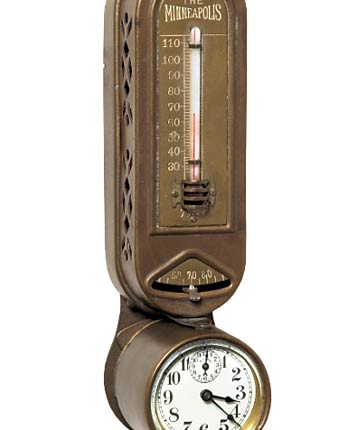The Secret History Of: The thermostat

Thermostats have been slow to catch on. Heating, like so much else, was invented by the Romans. Their version of underfloor radiant heating, called a "hypocaust", was surprisingly sophisticated and warmed the chilliest of villas and better still, public baths. It can get nippy inside marble buildings if you're running around naked and wet.
But you have to fast-forward to 1885 for the birth of the thermostat and the precise ability to control your heating. Whilst a "damper flapper" might sound more like the latest innovation in nappies (especially with the inventor called Albert Butz), it was in fact an ingenious device that could control a heating system.
Not dissimilar to a cat flap to look at, the flap lifted as it got cold, allowing the furnace to burn more fiercely, and lowered again as it got warmer.
Butz's patent and his business was snapped up and, in 1906, was bought out by a young engineer by the name of Mark Honeywell, who later unveiled the first programmable thermostat, the "Jewell", pictured. Featuring a built-in clock, it enabled users to turn down the heat at night and automatically adjust it to a pre-set temperature in the morning.
An electric clock was added in the 1930s and in 1953 Honeywell's famous round thermostat was unveiled. "One of the world's most recognisable designs, it remains in production and adorns the walls of more households around the world than any other thermostat," says Matthew Gordon, Honeywell's marketing manager.
The next big invention was separate outputs for heating and hot water and the 1980s saw the digital revolution. Or it should have done. Electronic thermostats have been surprisingly slow to catch on, with John Barclay, national sales manager for Siemens, admitting their blue-to-red dials are still hugely in demand, despite the option of slimline and even wireless remote digital controls which control heating far more accurately and flexibly. "When you think that by turning your heating down by one degree, you can save 10 per cent of energy, it's remarkable," he says.
Perhaps the new 3iE from Warmup will be the iPhone of thermostats. The world's first fully interactive thermostat with touch screen technology, it is clever, and undeniably, erm, cool. Then again, of the 22m British homes with central heating, a third don't have a thermostat at all.
Subscribe to Independent Premium to bookmark this article
Want to bookmark your favourite articles and stories to read or reference later? Start your Independent Premium subscription today.

Join our commenting forum
Join thought-provoking conversations, follow other Independent readers and see their replies